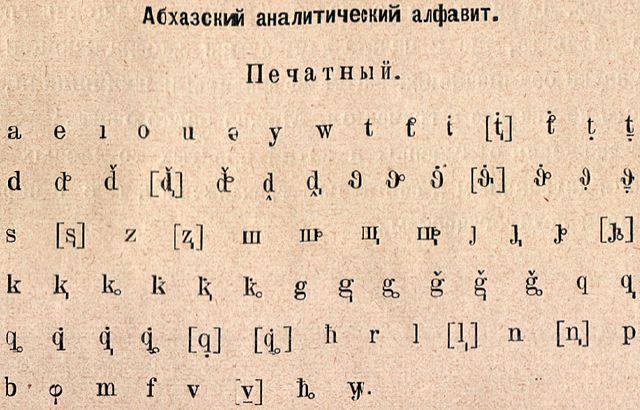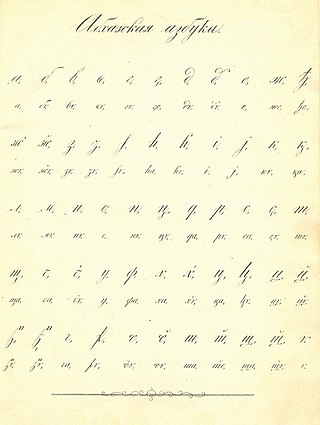Top Qs
Timeline
Chat
Perspective
Abkhaz alphabet
Cyrillic alphabet used for Abkhaz language From Wikipedia, the free encyclopedia
Remove ads
The Abkhaz alphabet is a Cyrillic alphabet used for the Abkhaz language.
You can help expand this article with text translated from the corresponding article in Russian. (April 2025) Click [show] for important translation instructions.
|










Abkhaz did not become a written language until the 19th century. Up until then, Abkhazians, especially princes, had been using Greek (up to c. 9th century), Georgian (9–19th centuries), and partially Turkish (18th century) languages.[2] The Abkhaz word for alphabet is анбан (anban), which was borrowed from Georgian ანბანი (anbani).
Remove ads
History
Summarize
Perspective
The first Abkhaz alphabet was created in 1862 by Peter von Uslar. It had 55 letters and was based on the Cyrillic script. Another version, having 51 letters, was used in 1892 by Dimitry Gulia and K. Machavariani.[3][4] In 1909, the alphabet was again expanded to 55 letters by Andria Tchotchua to adjust to the extensive consonantal inventory of Abkhaz.
In 1926, during the korenizatsiya policy in the Soviet Union, the Cyrillic alphabet was replaced by a Latin alphabet devised by Nikolay Marr. It featured 76 letters and was called the "Abkhaz analytical alphabet". In 1928, this was replaced by another Latin alphabet. (See illustration at right.) From 1938 to 1954 the Abkhaz language was written in Georgian Mkhedruli script.
Since 1954, the Abkhaz language has been written in a new 58-letter (now 64-letter) Cyrillic alphabet (see chart below). Of these, 38 are graphically distinct; the rest are digraphs with ⟨ь⟩ and ⟨ә⟩ which indicate palatalization and labialization, respectively. In 1996, the most recent reform of the alphabet was implemented: while labialization had hitherto been marked with two additional letters, ә and у (у was used in the digraphs гу, ҕу, ку, қу, ҟу, and ху, which were not considered separate letters), since then only ә was retained in this function. Unusually, the Cyrillic plosive letters К П Т represent ejective consonants; the non-ejectives (pulmonic consonants) are derived from these by means of a descender at the bottom of the letter. In the case of the affricates, however, the plain letters are pulmonic, and the derived letters ejective.
The modern Abkhaz orthography gives preference to the letters Г К П Т Х Ч with descender (Ӷ Қ Ԥ Ҭ Ҳ Ҷ). The letters (Ҕ Ҧ) had previously (before 1996) had a hook, which Ҕ still does in Yakut.[5] In pre-Soviet alphabets the hook was also used in Ӄ Ꚋ, see above.
The letters ь and ә are used as parts of digraphs, but are listed separately in the alphabet.[6] Besides the digraphs listed in the alphabet, the letter ь occurs in ль /lʲ/, which is used in some loanwords.[7]
Comparison table
Letters or digraphs in brackets are not part of the alphabet.[8] Letters without a modern equivalent represent phonemes only present in the Bzyb dialect, as the literary standard dialect switched from Bzyb to Abzhywa.[9]
Remove ads
Text Comparison
Article 1 of the Universal Declaration of Human Rights[18][better source needed]
Remove ads
See also
References
External links
Wikiwand - on
Seamless Wikipedia browsing. On steroids.
Remove ads
